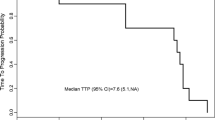Summary
Background Src kinase is central to tumor cell proliferation, apoptosis, and metastasis. KX2-391 is a synthetic, orally bioavailable small molecule inhibitor of Src tyrosine kinase (TK) signaling and tubulin polymerization. This compound is distinct from other Src kinase inhibitors by targeting the peptide substrate rather than the ATP binding site; the binding site on hetero-dimeric tubulin is novel and distinct from the taxanes and other known tubulin inhibitors. Methods This multicenter Phase I trial utilized a 4 + 2 study design to determine the maximum tolerated dose (MTD), safety, and pharmacokinetics (PK) of KX2-391 in patients with refractory solid tumors. Results Forty-four (44) patients (18 M, 26 F; median age, 59) were enrolled in 9 dose cohorts. Dose-limiting toxicities, all reversible within 7 days, occurred in 7 patients and consisted of elevated AST (n = 4), ALT (n = 2), neutropenia (n = 1), thrombocytopenia (n = 1), failure to thrive (n = 1) and anorexia (n = 1). The MTD is 40 mg BID continuously. Eleven patients had stable disease for ≥ 4 months, including patients with ovarian, carcinoid, papillary thyroid, prostate, pancreas and head and neck cancer. Patients with prostate and pancreatic cancer also had significant biomarker decreases (PSA, 205 ng/mL to 39 ng/mL; CA19-9, 38,838 U/mL to 267 U/mL). The ovarian cancer patient has had stable disease > 12 months. KX2-391 was orally available, rapidly absorbed, and exposure was proportional to dose across the range investigated. Conclusions KX2-391 has a favorable pharmacokinetic profile, is well tolerated, demonstrates preliminary evidence of biologic activity, and warrants further evaluation in Phase II trials.
Similar content being viewed by others
References
Summy JM, Gallick GE (2003) SRC family kinases in tumor progression and metastasis. Cancer Metastasis Rev 22(4):337–358
Puls LN, Eadens M, Messersmith W (2011) Current status of SRC inhibitors in solid tumor malignancies. Oncologist 16(5):566–578
Anbalagan M, Carrier L, Glodowski S, Hangauer D, Shan B, Rowan BG (2012) Kx-01, a novel SRC kinase inhibitor directed toward the peptide substrate site, synergizes with tamoxifen in estrogen receptor alpha positive breast cancer. Breast Canc Res Treat 132(2):391–409
Fallah-Tafti A, Foroumadi A, Tiwari R, Shirazi AN, Hangauer DG, Bu Y, Akbarzadeh T, Parang K, Shafiee A (2011) Thiazolyl n-benzyl-substituted acetamide derivatives: synthesis, SRC kinase inhibitory and anticancer activities. Eur J Med Chem 46(10):4853–4858
Lau GM, Yu GL, Gelman IH, Gutowski A, Hangauer D, Fang JW (2009) Expression of SRC and FAK in hepatocellular carcinoma and the effect of SRC inhibitors on hepatocellular carcinoma in vitro. Dig Dis Sci 54(7):1465–1474
James K, Eisenhauer E, Christian M, Terenziani M, Vena D, Muldal A, Therasse P (1999) Measuring response in solid tumors: unidimensional versus bidimensional measurement. J Natl Canc Inst 91(6):523–528
Zarbock A (2012) The shady side of dasatinib. Blood 119(21):4817–4818
Mould T (2012) An overview of current diagnosis and treatment in ovarian cancer. Int J Gynecol Canc Official J I Gynecol Canc Soc 22(Suppl 1):S2–S4
Yared JA, Tkaczuk KH (2012) Update on taxane development: new analogs and new formulations. Drug Des Dev Ther 6:371–384
Leung EL, Wong JC, Johlfs MG, Tsang BK, Fiscus RR (2010) Protein kinase g type ialpha activity in human ovarian cancer cells significantly contributes to enhanced src activation and DNA synthesis/cell proliferation. Mol Canc Res MCR 8(4):578–591
Le XF, Bast RC Jr (2011) SRC family kinases and paclitaxel sensitivity. Canc Biol Ther 12(4):260–269
Cai H, Babic I, Wei X, Huang J, Witte ON (2011) Invasive prostate carcinoma driven by c-SRC and androgen receptor synergy. Cancer Res 71(3):862–872
Rice L, Lepler S, Pampo C, Siemann DW (2012) Impact of the SRC inhibitor dasatinib on the metastatic phenotype of human prostate cancer cells. Clin Exp Metastasis 29(2):133–142
Acknowledgements
The authors would like to thank Lacey McQuinn and Joann Aaron in the Department of Investigational Cancer Therapeutics at the University of Texas MD Anderson Cancer Center for help in editing this manuscript.
Sponsored research agreement
Kinex Pharmaceuticals, LLC.
Disclosure of potential conflicts of interest
Lyn Dyster, PhD., David Hangauer, PhD., and Rudolf Kwan, MD are all employees of Kinex Pharmaceuticals and hold Kinex stocks or shares. All remaining authors declare no conflict of interest.
Précis
This drug was well tolerated, and it demonstrates preliminary evidence of antitumor activity and warrants further evaluation in Phase II trials.
Author information
Authors and Affiliations
Corresponding author
Rights and permissions
About this article
Cite this article
Naing, A., Cohen, R., Dy, G.K. et al. A phase I trial of KX2-391, a novel non-ATP competitive substrate-pocket- directed SRC inhibitor, in patients with advanced malignancies. Invest New Drugs 31, 967–973 (2013). https://doi.org/10.1007/s10637-013-9929-8
Received:
Accepted:
Published:
Issue Date:
DOI: https://doi.org/10.1007/s10637-013-9929-8




